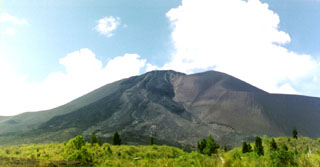Report on Soputan (Indonesia) — 12 June-18 June 2013
Smithsonian Institution / US Geological Survey
Weekly Volcanic Activity Report, 12 June-18 June 2013
Managing Editor: Sally Sennert.
Please cite this report as:
Global Volcanism Program, 2013. Report on Soputan (Indonesia) (Sennert, S, ed.). Weekly Volcanic Activity Report, 12 June-18 June 2013. Smithsonian Institution and US Geological Survey.
Soputan
Indonesia
1.112°N, 124.737°E; summit elev. 1785 m
All times are local (unless otherwise noted)
On 14 June CVGHM reported that, after the Alert Level at Soputan was raised to 3 (on a scale of 1-4) on 19 April due to a trend of increased seismicity, the number of various types of earthquakes decreased, except for events signaling avalanches, which fluctuated during the period. No changes were observed in emissions; white plumes continued to rise at most 50 m above the crater. On 14 June the Alert Level was lowered to 2. Residents and tourists were advised not to approach the craters within a radius of 4 km.
Geological Summary. The Soputan stratovolcano on the southern rim of the Quaternary Tondano caldera on the northern arm of Sulawesi Island is one of Sulawesi's most active volcanoes. The youthful, largely unvegetated volcano is the only active cone in the Sempu-Soputan volcanic complex, which includes the Soputan caldera, Rindengan, and Manimporok (3.5 km ESE). Kawah Masem maar was formed in the W part of the caldera and contains a crater lake; sulfur has been extracted from fumarolic areas in the maar since 1938. Recent eruptions have originated at both the summit crater and Aeseput, a prominent NE-flank vent that formed in 1906 and was the source of intermittent major lava flows until 1924.
Source: Pusat Vulkanologi dan Mitigasi Bencana Geologi (PVMBG, also known as CVGHM)

